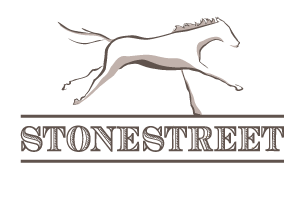The fastest workout a horse will accomplish prior to race day is a “breeze”, when a horse will travel approximately 1 furlong in 12 seconds. It is the final step for the two-year-olds at Stonestreet Training Center before they move to various trainers at the racetrack. As we learned in the blog “Race Track Training”, breezing is used to maintain and assess the fitness of all racehorses.
There are various lessons learned before a breeze. Style is prioritized over speed while these babies are still learning. When yearlings first arrive at the training center in September or October, they begin the education process called “breaking”. Cardiovascular fitness, musculature and bone building is achieved through exercise under tack and with regular paddock turn out.
Once the two-year-olds have learned the basics of being ridden and are comfortable galloping in a paddock, the next step is the jogging ring. The jogging ring is a small circular track where all horses jog to warm up before they head to the track. This is an opportunity for the Training Center Manger to assess each horse before a gallop or breeze. Once the two-year-olds are comfortable and confident in the jogging ring they move to the track for the first time. After several weeks of galloping on the track, fitness continues to increase until the two-year-olds are traveling 1 to 1 1/4 miles. The two-minute-lick is next before moving on to an actual breeze.
When breezing begins, the purpose is education. Unlike horses on the track, two-year-old works at our Training Center are not published. Traveling easy quarter miles in 13 or 14 seconds, the two-year-olds breeze in company. The first breezes are meant to get them into the bit and to teach switching leads at the turn, a maneuver needed on race day. “Into the bit” refers to the horse’s willingness to move forward under their own power with a steady, relaxed contact with the rider’s hands via the reins. Switching leads refers to altering which set of legs advances forward to the greatest extent when a horse is galloping. Switching leads can be crucial at the end of a race; switching the lead from left leg to right can give a horse a burst of renewed energy in the stretch run. This early education will allow a horse to relax on the track and enjoy their work. Two-year-olds will breeze alone for their final couple of breezes before they graduate from our training program.
Two key aspects a trainer must take note of during the process leading up to a breeze and when breezing begins are the mental and physical states of each individual horse. A horse that is physically strong with good conformation may not mentally enjoy breezing. Alternatively, a horse that looks forward to going to the track may not be able to withstand the physical pressure.
When a horse is compromised in either capacity, they will not be their best on the track. In these cases, the road to breezing is taken at a slower pace. This will reduce the impact of any physical problems as well as ensure the two-year-old maintains a happy attitude about training. By paying attention to the horse, a trainer will see signs of physical or mental stress.
When a two-year-old graduates from our training program, they will be familiar with many aspects of training. New experiences await them as they move on to their racetrack trainer with busier tracks and new routines, but they are prepared for their first recorded breeze with a solid base of fitness and a relaxed mind.
